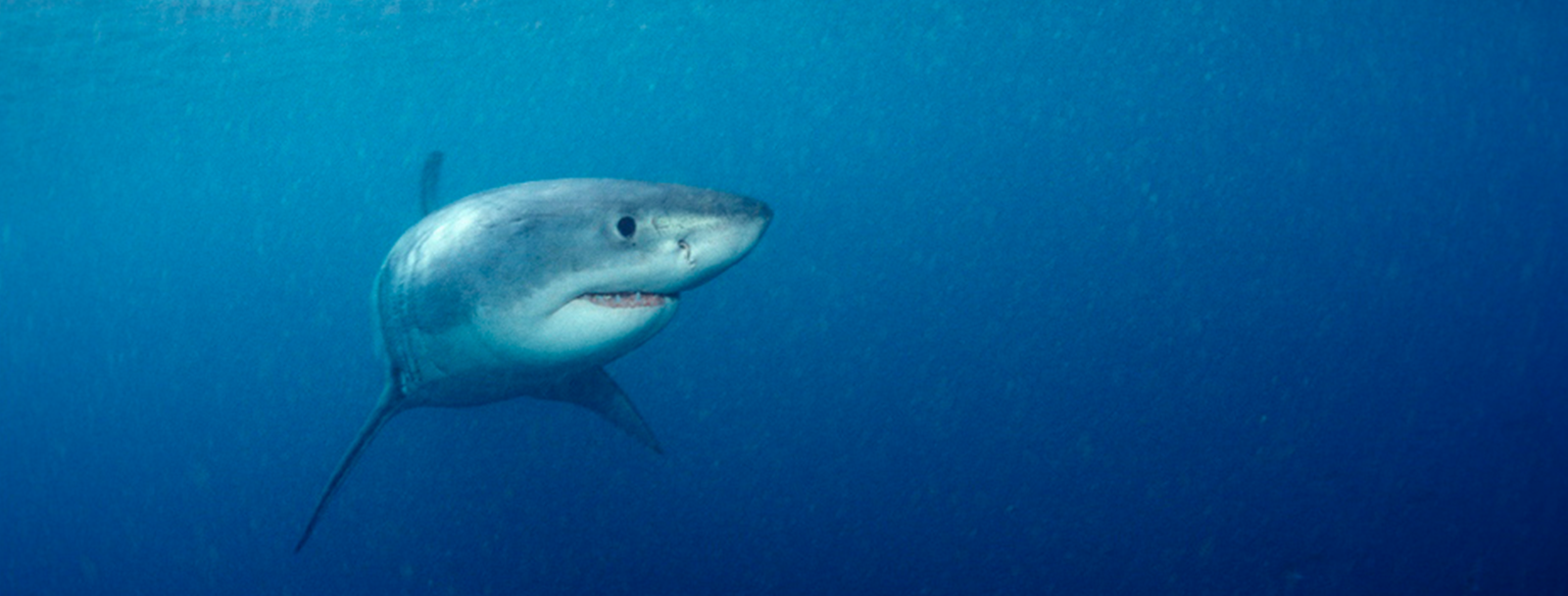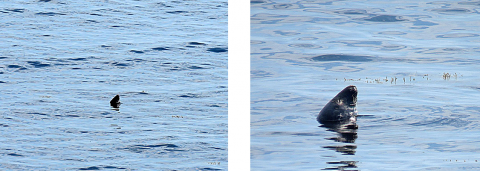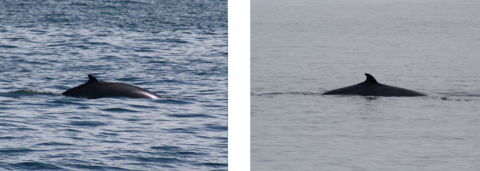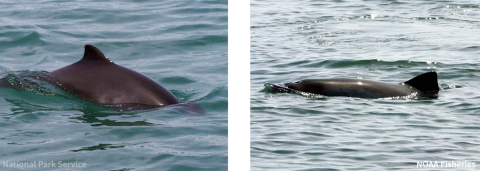
Sharks inspire both wonder and fear in people, but what do you need to know about sharks in the Gulf of Maine? In recent years, great white sharks (Carcharodon carcharias) especially have attracted a substantial amount of attention as sightings have increased in the Gulf of Maine, notably off the coast of Cape Cod, Massachusetts and most recently in a fatal attack in Harpswell, Maine (July 28, 2020). In the wake of shark sightings in the news and tragedies like shark attacks, it is natural to have questions and concerns about shark activity in our waters.
How to Stay Safe in the Water
A shark attack has never been documented in New Hampshire waters (1837 to present. Source: Florida Museum of Natural History - International Shark Attack Files), but recent great white shark attacks in neighboring states (Massachusetts and Maine), increased shark sightings, and recovering seal populations have drawn attention to the risks.
Gulf of Maine shark experts report that shark attacks in New England are extremely rare. When it comes to great white sharks, most attacks on humans are thought to be caused by mistaken identity. White sharks intend to target seals, a prey item that can look similar to a swimmer/surfer wearing a wetsuit.
The Atlantic White Shark Conservancy recommends the following actions to stay safe while recreating in and on the water. The only way to completely eliminate the risk of an encounter with a shark is to remain on shore. However, if you choose to enter the water:
- Be aware sharks hunt for seals in shallow water
- Stay close to shore where rescuers can reach you
- Swim, paddle, kayak and surf in groups – don’t isolate yourself
- Avoid areas where seals are present
- Avoid areas where schools of fish are visible
- Avoid murky or low visibility water
- Limit splashing
- Adhere to all signage and flag warnings at beaches
- Follow instructions of the lifeguards
- Download the Sharktivity App

Shark Bite First Aid
In the event of an attack, “most white shark bite victims survive because of first aid initiated from bystanders. White shark bites generally result in massive hemorrhaging which requires immediate first aid in order to stop the blood loss,” says the Atlantic White Shark Conservancy.
Minutes count! Someone who is severely bleeding can bleed to death in as little as 5 minutes. That’s why bleeding control – keeping the blood inside the body – is the purpose of STOP THE BLEED® training, which can be applied in a multitude of accidents, including a shark bite.
To get more information on the training program, visit www.stopthebleed.org.
Identifying and Misidentifying Shark Fins
Shark expert Dr. John Chisholm with the @MA_Sharks Twitter Account and Massachusetts Division of Marine Fisheries reminds us that “not every fin you see belongs to a white shark or even a shark for that matter.”
But remember, if you see something in the water that you're unsure about, always err on the side of caution and get out of the water to a safe place on shore!
The following fin identification and misidentification information was shared by the @MA_Sharks Twitter Account with additional details provided by the NH Sea Grant team:
The following characteristics are used to positively identify white sharks (Carcharodon carcharias):
- White sharks have a pointed dorsal fin
- White sharks have two-tone coloration (darker on the top/dorsal side and lighter on the under/ventral side)
- White sharks have large gill slits

The main culprit in white shark misidentifications is the basking shark (Cetorhinus maximus), a species that filter feeds for plankton and does not have teeth.
- Basking sharks have a rounded dorsal fin
- Basking sharks have uniform coloration
- Basking sharks have extra large gill slits that expand outwards when they are filter feeding
Check out this video explaining how to identify white shark fins vs. basking shark fins for more information and comparison images.

The fin of the ocean sunfish (Mola mola) is often confused for a shark's fin.
Sunfish have prominent dorsal fins. When a sunfish is at the surface, its fin can extend out of the water and often flaps or splashes side to side (fins can appear and then disappear several times near the same location on the surface). This fin movement is one indication that the fin does not belong to a shark, whose dorsal fin would not exhibit that sort of movement at the surface.

A recent and growing number of mistaken identity reports are turning out to be gray seals (Halichoerus grypus).
When resting or sleeping on the surface, seals may lift their heads out of the water and point their noses upward (a behavior called "bottling"). In this position, seal heads can resemble a shark fin.

Minke whales (Balaenoptera acutorostrata) can also result in cases of misidentification. Their dorsal fins have a more distinct "hook" shape than the fin of a shark, and you may notice the back of a minke whale at the surface, which arches before the whale dives deeper.
Minke whales generally surface quickly and transit through an area without lingering close to shore. They are the smallest baleen whale in our waters, and are commonly sighted by vessels in the Gulf of Maine.

Dolphins, like the Atlantic white-sided dolphins (Lagenorhynchus acutus) pictured above, are common in our waters and their dorsal fins can be mistaken for shark fins. Like minke whales (see previous tab), a dolphin's dorsal fin will have a more distinct "hook" shape than a shark fin.
Dolphins usually travel in social, family groups (called "pods"), so you may see several dolphin fins appear together at the surface. Sharks are solitary animals and it would be rare to see several shark fins traveling together.

The harbor porpoise (Phocoena phocoena) is another marine mammal species known to frequent nearshore and offshore waters of the Gulf of Maine.
Their dorsal fins are rounder and smaller than the dorsal fins of dolphins, but like dolphins they may be seen in social/family groups with a few to several individual porpoises traveling together.
Seals in New Hampshire

In New Hampshire, the Seacoast Science Center’s Marine Mammal Rescue program works as a part of the Greater Atlantic Regional Marine Mammal Stranding Network, responding to incidents of seals and other marine mammals from Essex, MA to Maine’s southern border. This team of staff and volunteers are experts on seals in our local waters and shores.

In a 2020 blog post, Brian Yurasits, Marine Mammal Rescue Community Outreach Manager for the Seacoast Science Center (SSC) Marine Mammal Rescue program shared, “Our team collects data and samples on these animals to help us better understand how seal populations are changing in the Gulf of Maine. Our work contributes to the scientific process that identifies and manages threats to marine mammal populations. SSC has recorded 8 suspected or confirmed shark predations on seals in our response territory since 2014. However the vast majority of observed seal mortalities – that were investigated by means of a full post mortem examination – are related to disease, infection, and juvenile abandonment.”
To report any stranded marine mammal, live or dead, in New Hampshire call the Seacoast Science Center’s Marine Mammal Rescue Hotline: (603) 997-9448
Additionally, the Shoals Marine Laboratory on Appledore Island in the Isles of Shoals leads a long-term seal monitoring program tracking the annual abundance and distribution of gray seals and harbor seals on Duck Island and its surrounding rocky ledges. Researchers and undergraduate interns at Shoals Marine Laboratory have conducted boat-based photographic surveys annually since 2011. Their survey images have documented seals with injuries believed to be causes by sharks. Other ailments, skin lesions, and indications of disease have been documented, as well as instances of seals entangled in fishing gear.
Dr. Andrea Bogomolni, lead investigator for the study, report that individual surveys around Duck Island in the Isles of Shoals regularly document over 600 harbor seals (Phoca vitulina) and gray seals (Halichoerus grypus) hauled out on the rocks in the height of the summer months, when the Duck Island seal colony is at its peak size.
Setting the Scene: Why are we seeing more sharks and seals in the Gulf of Maine?
While they may seem like newcomers, white sharks (Carcharodon carcharias) are native to the Gulf of Maine and have historically inhabited the waters along the coasts of the Northeast U.S. and Canadian Maritimes as well as offshore in the Northwest Atlantic Ocean.
Though the Gulf of Maine makes headlines for rapidly warming waters and other adverse impacts of climate change, warmer waters are not necessarily the reason for more white sharks. The increased sightings and presence of white sharks in New England waters are largely due to marine conservation and fisheries management efforts over the last several decades – representing a conservation and management success story. Increasing shark populations may be a sign that the marine food web is rebounding after generations of exploitation. Robust populations of apex predators like sharks are considered to be signs of a healthy ecosystem and indicators of recovering prey populations and improved biodiversity.
Seals, like sharks, play an important role in our healthy marine ecosystems. Seals are also native to the Gulf of Maine but were nearly eradicated in Northwest Atlantic waters due to hunting and culling before legal protections were established in the 1970’s. Long-standing conflicts between humans and seals were related to perceived impacts of marine mammals on economically valuable fishery resources, based on beliefs that seals consume “too many” fish and introduce parasites that infect and reduce the value of landed fish stocks. Interactions between seals, fish, and people remain a complicated topic for marine policy and management.
Both white sharks and seals in the Gulf of Maine experienced dramatic population declines at the hands of humans and their populations have only recently begun to recover. In the 1970’s, key legislation related to marine mammals and fisheries changed the policy and management landscape in U.S. waters by restricting and managing harvests and providing legal protection for certain species.
- In 1972, The Marine Mammal Protection Act (MMPA) was passed into law to prohibit the take and exploitation of any marine mammal without appropriate authorization in the U.S. Prior to the MMPA, seal populations in the Gulf of Maine had plummeted due to bounties paid for their extermination, hoping to prevent seals from competing with commercial fishermen.
- In 1976, the Magnuson-Stevens Fishery Conservation and Management Act was enacted as the primary law governing marine fisheries management in the U.S. The motivation behind the Act was to both manage harvest in commercial fisheries and provide a framework for conservation of commercially important marine fishes. White sharks as a species are currently managed in the U.S. under the Magnuson-Stevens Act, and an amendment in 1997 prohibited their capture in Atlantic federal waters.
Today, the exact population numbers for white sharks in the Northwest Atlantic Ocean (which includes the Gulf of Maine) are unknown due to wide ranges of seasonal migration and foraging patterns – which is the case for many marine species.
For seals, population estimates are determined by stock assessment reports, which are required under the U.S. Marine Mammal Protection Act (MMPA). The harbor seal population is estimated at 70,000 individuals (potentially declining). For gray seals, the population estimate is approximately 27,000 in U.S. waters based on pup production, and over 500,000 in the Northeast Atlantic including Canadian waters. (Source: https://www.sealconsortium.org/faq).
Sightings of white sharks in the Gulf of Maine are relatively rare, and reports tend to come from vessels at sea or a predation event on a marine mammal. Sightings data, catch records, and tagging data indicate that white sharks usually occur in the Gulf of Maine region from the early summer through the fall. On Cape Cod, for example, white shark activity typically peaks in August.
It is important to remember that seals are not the only food source of white sharks. Although some large white sharks eat seals, their diet includes other marine life like fish and other marine mammal carcasses. It is not fully understood how seal populations influence the abundance, distribution, or behavior of white sharks. However, experts believe that shark attacks on people are often caused when white sharks mistake a human for a seal.
As conservation and management efforts in the Gulf of Maine ecosystem restore populations of marine life, we expect to see examples of species interactions that appear to be “new” to us given our frames of reference and ways of living. However, before human impact on our ecosystems, these species and interactions would have been more common – for example, white sharks hunting seals in New England waters. Additionally, we know that human populations and development along our coasts have greatly increased, and with that, human interactions with marine animals like sharks and seals will become more frequent. Put simply, more people in the water and more sharks can lead to more human-shark interactions.
It is important to remember that shark attacks remain very, very rare. White shark populations in the region have been increasing for at least the past two decades, largely without notice.
Even though interactions between sharks and humans remain rare, those using our marine waters can be proactive. This includes exercising caution when seals are in the area or if large schools of fish are present. If you are in the water and notice animals exhibiting strange behavior such as attempting to hide using surfboard or flotation device, be vigilant and get out of the water. In addition, avoid being alone in the water or during dawn or dusk.
It is important to develop informed opinions and make fact-based decisions about our coastal/marine resources and our experiences in, on, or near the water. We hope that this information will help New Hampshire’s coastal residents, visitors, beachgoers, swimmers, surfers, fishermen, boaters, and others better understand why and how human-shark interactions occur and how to stay safe.
This story has been reviewed by Dr. Nathan Furey, assistant professor of biological sciences at the University of New Hampshire, Dr. Andrea Bogomolni, chair of the Northwest Atlantic Sea Research Consortium, and Dr. Erik Chapman, director of NH Sea Grant.
ABOUT NH SEA GRANT
As a science-based, community-serving organization, NH Sea Grant has compiled this collection of shark information and resources from local and regional experts to help keep New Hampshire’s coastal residents, visitors, and beachgoers informed. Thank you to the individuals and organizations who have made this information available. Acknowledgements are included in each section and at the bottom of the page.
QUESTIONS ABOUT ANY OF THE CONTENT SHARED HERE?
Email nh.seagrant@unh.edu
REFERENCES FOR PAGE CONTENT:
- Atlantic White Shark Conservancy - Public Safety Resources
- Florida Museum of Natural History - International Shark Attack File
- North Carolina Sea Grant - Shark Sense: Atlantic and Gulf Regions
- Movements of the white shark Carcharodon carcharias in the North Atlantic Ocean. Skomal et al. (2017)
- Seasonal Distribution and Historic Trends in Abundance of White Sharks, Carcharodon carcharias, in the Western North Atlantic Ocean. Curtis et al. (2014)
- White Shark Recovery (podcast). NOAA Fisheries (2014)
- Understanding Atlantic Shark Fishing. NOAA Fisheries (2019)
- Facts, but no easy answers, around shark bites in New England. Boston Globe. Whitney and Skomal (July 31, 2020)
- Expert Reveals What Probably Led to Deadly Great White Shark Attack. Boston10 News. Michaelson and Sulikowski (July 30, 2020)
- Sharks, Seals, and a Healthy Ocean Ecosystem. Seacoast Science Center blog (August 1, 2020)
- Northwest Atlantic Seal Research Consortium - FAQs
- Marine Mammals of Maine Facebook post (July 30, 2020)
- Marine Mammal Protection Act - NOAA Fisheries
- Magnuson-Stevens Fishery Conservation and Management Act - NOAA Fisheries